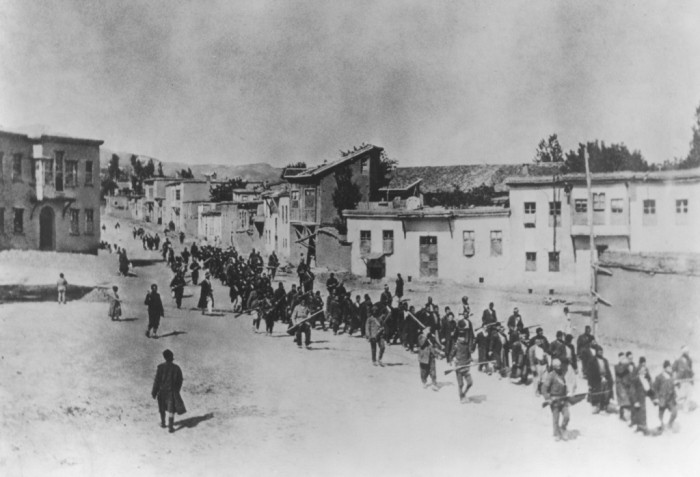
April 24, 1915, was the day that shaped my life, yet I wasn’t even alive. This was the day of the Armenian Genocide, one of the most tragic and controversial chapters in our history. Between 1915 and 1923, the Ottoman Empire conducted a series of ethnic cleansing, targeting the Armenian, Greek, and Assyrian minorities. It is estimated that 1.5 million Armenians lost their lives to the mass killings. Even despite its damages, the Armenian Genocide still isn’t fully recognized in the political scene. In fact, Adolf Hitler famously stated, “Who, after all, speaks hoy of the annihilation of the Armenians?" Using the argument that if society forgot about the Armenian Genocide, they would forget about the Holocaust, too (Armenian-genocide.org).
For me, the Armenian Genocide isn’t just a part of history; it’s a deeply personal story. My family’s roots trace back to a small village in northwestern Armenia, Gyumri, a target of the Ottoman Empire’s plans. Due to this event, life in Gyumri was difficult. Citizens were constantly in a state of fear and poverty. My great-grandmother, a beacon of strength, owned a Middle Eastern headdress adorned with sterling silver coins. She would trade each coin within her village for necessities, such as potatoes, flour, and even salt. Each fleeting coin represented a thread in the tapestry of the damages done during this historical period. Just before all the coins on the headdress were traded away, her life was taken by an Ottoman soldier. As the village was raided, my great-grandfather was preparing to flee to the capital of Armenia, Yerevan. To keep his family’s valuable jewelry safe from the soldiers, he wore it all. Head to toe, he was decorated with silver and gold traditional Armenian necklaces, bracelets, and rings, while he kept multiple pairs of earrings in his pockets. As he left his small house, he was killed and tortured by an Ottoman soldier, and all the jewelry he dedicated to protect was taken along with his life.
April 24, now known as Armenian Genocide Remembrance Day, is always a hard day for my family, filled with sorrow and mourning for our lost ancestors. However, I learned, even though it is hard, to look at the good side of this event. I realized that my ancestors used optimism to take back their culture from the Ottoman Empire and rebuild their nation piece by piece to make it stronger than ever, displaying their survival and perseverance in all their actions. Therefore, I grasped that optimism isn’t about denying pain but finding strength in the face of adversity.
Despite the Armenian cultural heritage nearly being erased, the nation, despite the horrors they faced, rebuilt their lives and passed on their traditions. Their refusal to be defined by their suffering is a profound display of optimism rooted in action and initiative, which allowed me to realize that optimism isn’t just a naive hope but a deliberate choice requiring strength. It is easy to give into despair when faced with hardships, but optimism isn’t passive; it requires courage. It requires finding meaning in suffering and pushing forward, even if it’s hard.
The Armenian diaspora is one of the most prominent examples of the resilience and cultural preservation of the Armenians. As a result of the genocide, many Armenians were forced to flee their ancestral homeland, ending up in countries such as the United States, Lebanon, Syria, France, Argentina, and Palestine, to name a few. Despite being scattered across the globe, they have managed to maintain a strong connection to their roots, whether that is displayed through food, music, or art. Charles Aznavour, a renowned singer and songwriter, was born in France and was the son of parents who had escaped the genocide. Despite separating from the country, he spoke and sang in Armenian, never forgetting his roots (Songhall.org).
Growing up immersed in the narratives of my ancestors’ resilience following the Armenian genocide indeed influenced my perspective on optimism. I recognized that authentic optimism involves acknowledging hardships while taking the initiative for renewal and growth. This perspective influenced my approach through challenges I have faced in my life, guiding me to use determination and resilience while acknowledging that optimism is a force that takes activity. Embracing this form of optimism has allowed me to pave my entire life, inspiring me to use this found flame to guide me daily.
Works Cited
Bardakjian, Kevork B. “Adolf Hitler, Chancellor of Nazi Germany (1933-45).” Armenian National Institute, 1985, https://www.armenian-genocide.org/hitler.html. Accessed 1 March 2025.
“Charles Aznavour | Songwriters Hall of Fame.” Songwriters Hall of Fame, https://www.songhall.org/profile/Charles_Aznavour. Accessed 1 March 2025.
This article won the Pacific Central District Award for the Optimist International Essay Competition.